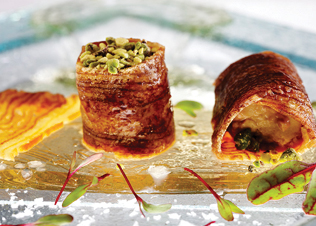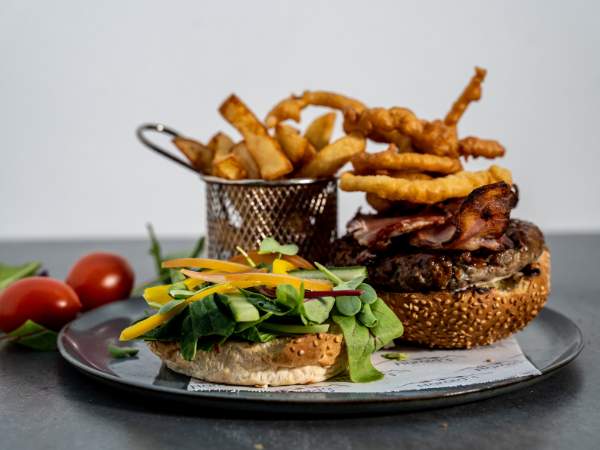News
Best of nouvelle
Monday, March 12th, 2012
“Appetite comes with eating,” wrote François Rabelais in Gargantua, which is precisely why nouvelle cuisine failed.
What we understand by the term today (nouvelle cuisine was actually a recurring appellation in French cuisine from the 18th century onwards) had its peak around the time of restaurant critic Henri Gault’s 1973 manifesto. But it has left an indelible impression on today’s fine-dining restaurants.
Among Gault’s 10 points were an emphasis on leaner, cleaner fare, the freshest produce, light meals and salads without bowing to “men in a hurry and women on a diet”, the banishing of many traditional sauces for having “assassinated so many livers” and the embracing of new technology and not letting “out cries like violated virgins” at the sight of the modern batterie de cuisine.
Unfortunately, nouvelle cuisine, which started as an attempt to be more natural, honest and pure, became synonymous with minuscule portions of raw food, preposterous descriptions, dishonest menus and obsessive-compulsive plating.
Aubergine Restaurant opened in 1996. It extended this distinctly modern European culinary approach to Cape Town’s restaurant scene and did it in an 1830 home, once the residence of the first Cape chief justice, Sir John Wylde. When others had long abandoned nouvelle cuisine Aubergine was still committed, fortunately, to the best aspects of the original philosophy.
Size matters
But I remember eating there soon after it opened and feeling deflated. The food was good and the presentation impeccable, but my Rabelaisian appetite had me scurrying home to cook.
There is no virtue in starving. I wanted to shout: “If you can make food taste this good, why not give your diner a respectably sized helping?” Several other restaurants at the time were delivering precisely that — same quality, decent size.
But the fact that the restaurant has not only endured but prospered — and won numerous awards — must be a testament to something. Last week I returned with dining partner Munchkin to try to figure out why.
Recent renovations have enhanced the dining experience. The setting is immaculate; the service excellent. The yellowwood tables, Knysna blackwood floors and the soaring volume of the space certainly impress locals and foreigners alike. Much of the clientele remains the older tourists.
Chopin was playing; later it was the Buena Vista Social Club from Cuba.
A tome of a wine list includes an extensive inventory of German riesling and other foreign wines.
We took the liberty of bringing our own Méthode Cap Classique sparkling wine. Not an eyelid was batted. In fact, the sommelier swapped it for a colder bottle in the fridge and the waitress gave us an opportunity to taste whether the bottle was okay. The corkage was R80.
Delicate tastes
A neatly packaged amuse bouche arrived on a triangular plate and rather appropriately contained aubergine with mayonnaise, julienne celeriac, a basil leaf and a coin of kudu meat.
For starters Munchkin had two spicy Indian dhal vaddes (lentil patties, R78) — small, ring-shaped, deep-fried and accompanied by pineapple relish and crispy lettuce with a yoghurt dressing.
I ordered the slices of duck breast (R95), wrapped Asian style in a thin mandarin pancake, set on rectangles of firm mango, delicately sauced and garnished with cilantro leaves.
The starters demonstrated chef Harald Bresselschmidt’s penchant for East meets West. His approach is conservative. What he does particularly well is not to adulterate a Western dish with serendipitous, or, as is so often the case, opportunistic, Asian influences. Instead, he creates what is an almost completely Western version of an Asian idea, in this instance, Peking duck. His conceptions thus stand on a firm footing.
Next, a complimentary palate- cleansing sorbet arrived in an elegant glass.
For mains, Munchkin had pasture-reared lamb (R198) from the Spier biodynamic farm. The portions remain modest but are far bigger than I recall. Still, Munchkin declined to share.
Bit parts
I had the seared ostrich fillet (R192) — two perfectly cooked medium-rare slices, with three sweet peas and three halves of cherry tomato.
Perhaps being a food critic who eats out far too much has quenched my gluttony. But the opulence of these dishes was such that one felt quite satisfied.
Munchkin had an elaborate plate that contained a grape strudel purse (R84) with caramelised ginger, orange sauce and prematurely melted elderflower sorbet. Clearly, the kitchen displays a certain passion for desserts.
Finally, a complimentary plate of dainty petits fours arrived with the bill.
Aubergine’s success, like the German economy, arises from sound management, a methodical approach, conservative policies and reliability.
This time I was won over and saw the wisdom of Bresselschmidt’s way.
By Brent Meersman for Mail & Guardian online
Photograph: David Harrison









